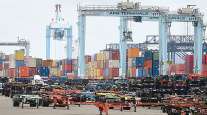Staff Reporter
DOT Unveils Interactive Map to Promote Infrastructure Investment

[Stay on top of transportation news: Get TTNews in your inbox.]
The U.S. Department of Transportation recently unveiled an interactive map depicting federal investment in major infrastructure projects in underserved rural and urban communities.
The map, which was announced Jan. 6, is meant to encourage economic investment in Opportunity Zones, which DOT defines as “economically distressed” communities designated by the state’s governor and certified by the U.S. Secretary of the Treasury.
“Opportunity Zones have the potential to increase job creation in underserved communities, especially in rural areas, and the department is working to ensure there are transportation links to Opportunity Zones,” Secretary of Transportation Elaine Chao said in a statement.
Specifically, DOT’s map presents datasets for major federal highway projects, interstate exits, bridges on the National Highway System, train and bus stations, major ports and intermodal facilities.
The urban areas on DOT’s interactive map, highlighted in pale yellow, include major metropolitan centers such as Boston, New York, Atlanta, Chicago, the Twin Cities, Houston and Los Angeles. The rural Opportunity Zones, marked in green on the map, are dispersed throughout the country, with particularly large pockets in Arizona, Utah, Colorado, New Mexico, Montana and Washington.
Established in 2017 as part of the Tax Cuts and Jobs Act, Opportunity Zones were created to boost economic development in low-income communities. In particular, they are meant to generate economic development by providing tax benefits to investors.
More than 8,700 Opportunity Zones have been designated in all 50 states, five territories and Washington, D.C.; of the qualified Opportunity Zones, 40% are in rural census tracts, 38% are in urban tracts and 22% are in suburban tracts.
DOT has tried to engage the zones by updating the criteria of federal infrastructure programs. For example, in the latest round of Better Utilizing Investments to Leverage Development (BUILD) discretionary grants, issued Nov. 12, half of the $900 million in funding was awarded to projects in rural areas.
The agency has issued 13 Notices of Funding Opportunity containing language geared toward Opportunity Zones. According to DOT, these programs awarded more than $2 billion in fiscal 2019.
Also, DOT in October created the Rural Opportunities to Use Transportation for Economic Success program to better understand transportation needs in rural communities. Known as ROUTES, the program is meant to help connectivity in those areas.
The initiative’s steering council includes representatives from the Federal Highway Administration, the Federal Transit Administration, the Federal Railroad Administration and the Federal Aviation Administration.
USDOT today announced a new interactive map highlighting federal investment in major #infrastructure projects located in and around Opportunity Zones. An Opportunity Zone is an economically distressed community. Read more here: https://t.co/4nUQAh3dLO pic.twitter.com/8vGBcBDEps — TransportationGov (@USDOT) January 6, 2020
In December, Chao called for public comments on the program to gather feedback on rural transportation needs and DOT’s grant programs.
Rural roads make up 70% of America’s road miles, according to DOT. Maintaining these roadways can be a challenge for rural communities that have thin financial resources. Although geographically sprawling, rural communities generally have low population densities, meaning fewer people to support investment.
DOT found that, although one-fifth of Americans live in rural areas, traffic fatalities are disproportionately high on rural roads. Some 46% of the traffic fatalities that occurred in 2018 took place on rural roadways.
Want more news? Listen to today's daily briefing:




